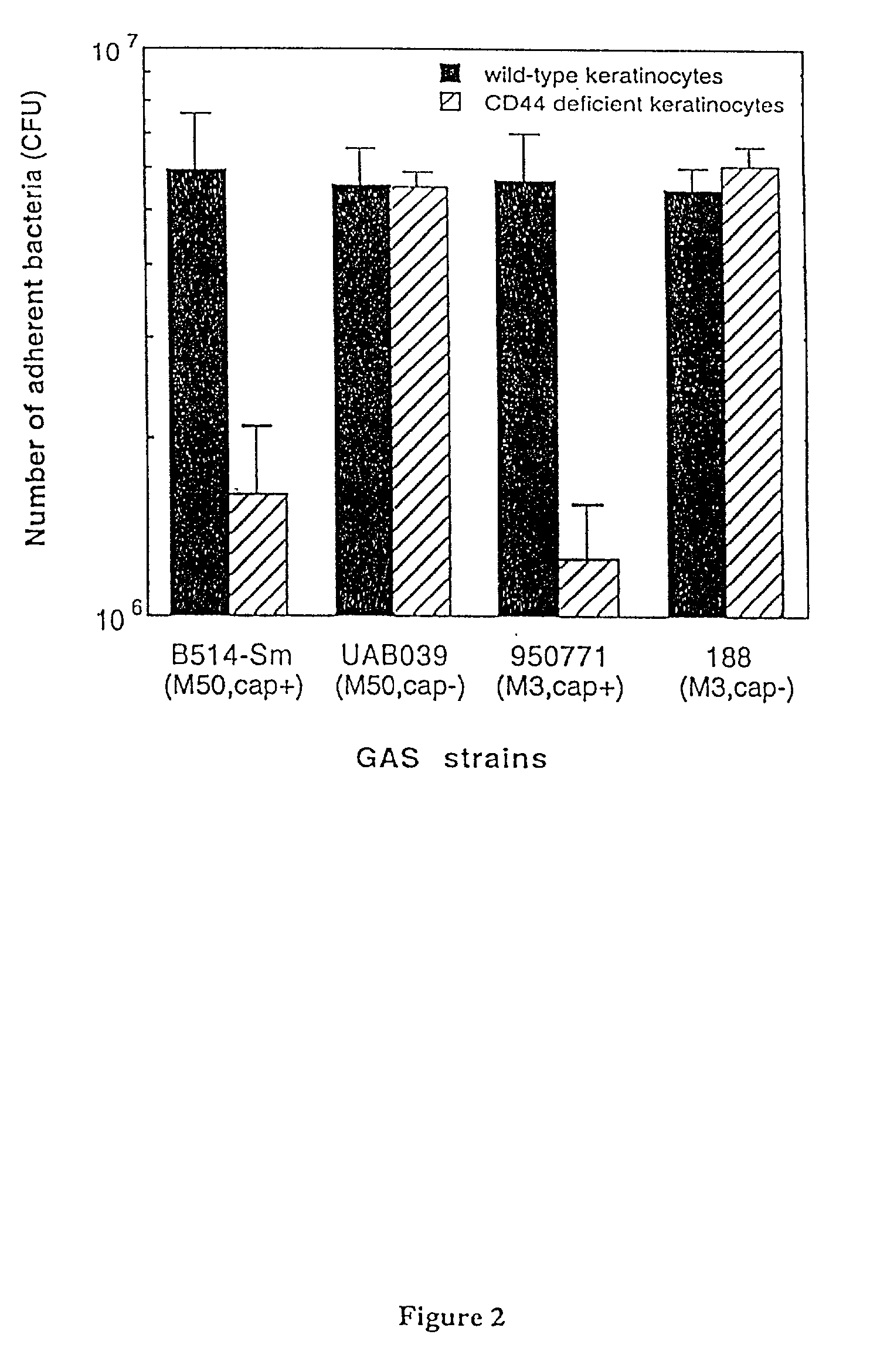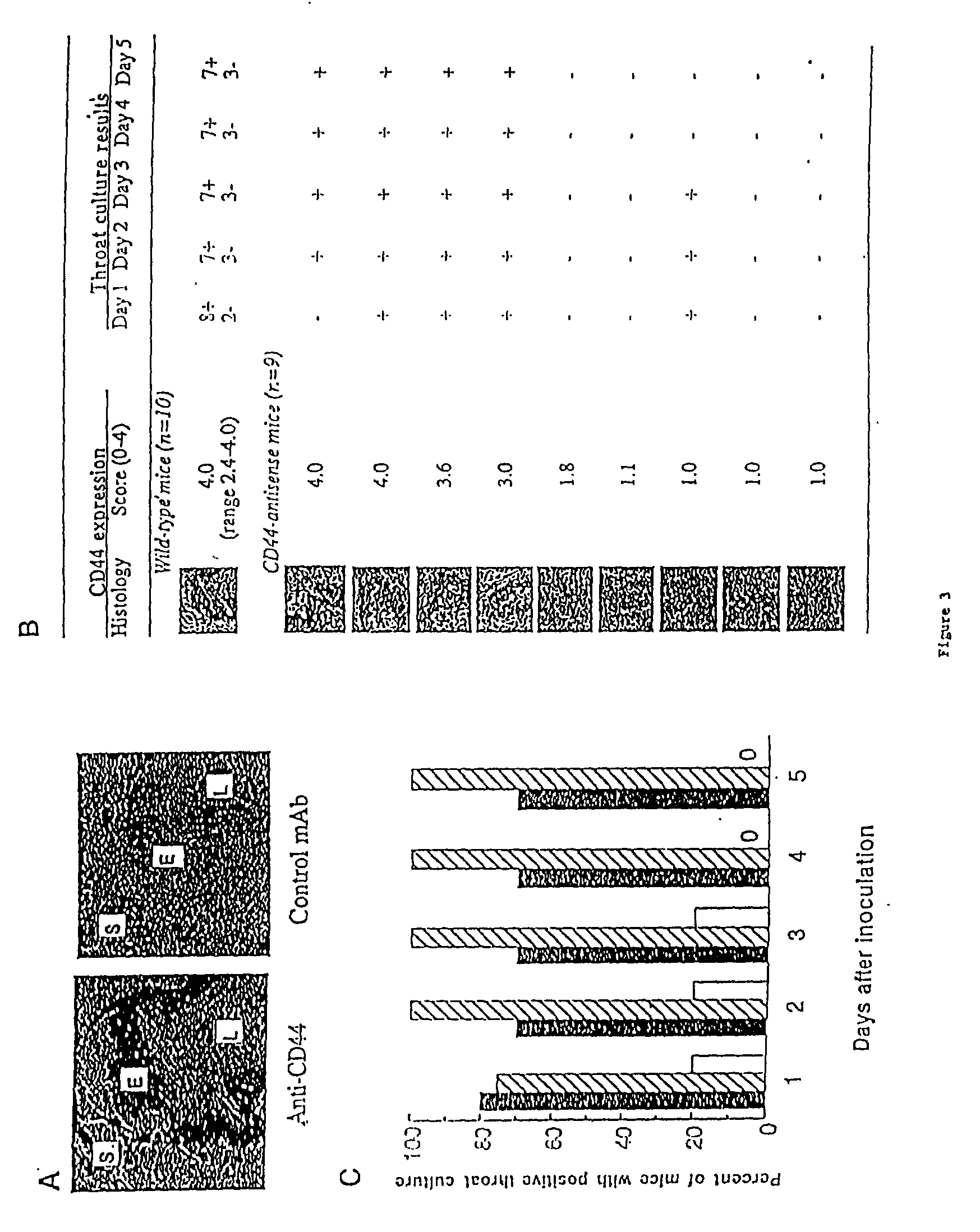Prevention and treatment of streptococcal and staphylococcal infection
a staphylococcal infection and streptococcal technology, applied in the field of prevention and treatment of streptococcal and staphylococcal infection, can solve the problems of numerous obstacles to hyaluronic acid binding in vivo, and do not serve as a model for in vivo binding
- Summary
- Abstract
- Description
- Claims
- Application Information
AI Technical Summary
Problems solved by technology
Method used
Image
Examples
examples 1-7
[0110] Bacterial Strains and Growth Conditions.
[0111] GAS strain B514-Sm is a spontaneous streptomycin-resistant derivative of B514 / 33, an M type 50 strain originally isolated from an epizootic infection of a mouse colony (Husmann, L. K., et al. 1996, Microb. Pathog. 20:213-24, Hook E. W., et al. 1960, Am. J. Hyg. 72:111-119), UAB039 is an acapsular mutant of B514-Sm constructed by insertion of a nonreplicating plasmid within the hasA (hyaluronate synthase) gene (Husmann, L. K. et al. 1997, Infect. Immun. 65: 1422-1430). GAS strain 950771 is an M type 3 strain originally isolated from a patient with necrotizing fasciitis; strain 188 is an acapsular mutant of 950771 constructed by insertion of the .OMEGA.Km2 element, a kanamycin-resistance cassette flanked by transcriptional terminators, within the hasA gene (Ashbaugh, C. D., et al. 1998, J. Clin. Invest. 102:550-560). Bacteria were grown in liquid culture in Todd-Hewitt broth or on trypticase soy agar containing 5% sheep blood. GAS ...
example 1
GAS Attachment to Murine Keratinocytes in vitro is Mediated by Binding of the GAS Capsular Polysaccharide to CD44
[0124] To define the importance of GAS interaction with CD44 in pharyngeal colonization in vivo and to determine whether a murine model would be suitable for this investigation; experiments were preformed to establish that GAS attachment to primary cultured murine keratinocytes, like that to human keratinocytes, was mediated by binding of the GAS capsular polysaccharide to CD44.
[0125] To examine the role of CD44 in GAS binding to murine keratinocytes, primary cultures were established of cells isolated from neonatal C57BL / 6 mouse skin. Two GAS strains were studied: B514-Sm, an M-type 50 strain that has been shown to efficiently colonize the upper airway of mice after intranasal inoculation, and 950771, an M-type 3 isolate originally cultured from a patient with necrotizing fascutis and typical of strains that cause human pharyngitis and invasive infection. Monoclonal anti...
example two
Encapsulated GAS Attach Poorly to CD44 -Deficient Keratinocytes from Transgenic Mice
[0126] CD44 -deficient transgenic mice were utilized to determine whether the selective loss of CD44 expression by keratinocytes affected GAS binding to keratinocytes in vitro and GAS colonization of the pharynx in vivo. K5-CD44 mice express a CD44 -antisense transgene under the control of the keratin-5 promoter which targets expression of the antisense transgene to the basal cell compartment of stratified squamous epithelia (Kaya, G. 1997, Genes and Development. 11:996-1007). High level expression of the transgene results in complete loss of CD44 expression in all layers of the epidermis. Transgenic animals were screened for high-level expression of the antisense transgene by immunofluorescence microscopy of primary cultured keratinocytes using mAb KM81. The attachment of GAS to primary keratinocytes from wild-type C57BL / 6 mice was compared to GAS attachment to K5-CD44 keratinocytes from antisense t...
PUM
| Property | Measurement | Unit |
|---|---|---|
| time period | aaaaa | aaaaa |
| time | aaaaa | aaaaa |
| time | aaaaa | aaaaa |
Abstract
Description
Claims
Application Information
 Login to View More
Login to View More - R&D
- Intellectual Property
- Life Sciences
- Materials
- Tech Scout
- Unparalleled Data Quality
- Higher Quality Content
- 60% Fewer Hallucinations
Browse by: Latest US Patents, China's latest patents, Technical Efficacy Thesaurus, Application Domain, Technology Topic, Popular Technical Reports.
© 2025 PatSnap. All rights reserved.Legal|Privacy policy|Modern Slavery Act Transparency Statement|Sitemap|About US| Contact US: help@patsnap.com



